6 Predictions for Earthquakes in New York Dating Back Over 100 Years
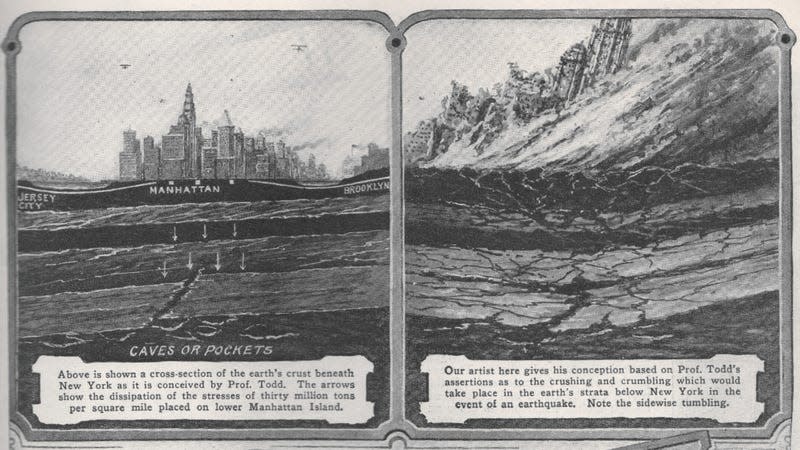
New York and New Jersey were jolted by a 4.8 earthquake on Friday morning, a rare occurrence in the region. But we can’t say we weren’t warned. Scientists have been predicting The Big One could hit New York at some point. And the predictions date back over a century.
The illustrations above ran in the November 1924 issue of Science and Invention magazine. The magazine was founded by sci-fi legend Hugo Gernsback, and these were very earnest predictions for the future of New York. The drawings depicted how Manhattan might crumble under its own weight in the event of an earthquake, all because there were “caves or pockets” underneath the surface.
From the 1924 article:
A prediction that some time in the not far distant future New York City would, be shaken by an earthquake more terrible than the one which wrecked Tokio [sic] last Summer was made today by Professor David Todd, professor of astronomy at Amherst College.
There were a number of articles published in the mid-1920s about earthquakes in urban areas after that particularly deadly quake hit Japan on September 1, 1923. The event would claim over 140,000 lives after the tsunami and fires ripped through Tokyo and Yokohama.
Incredibly, some people of the 1920s blamed new technologies like radio for causing earthquakes. But given the ridiculous beliefs of people on social media here in 2024, maybe we shouldn’t judge them too harshly.
The 1920s was a heyday for anxiety about New York getting hit with an earthquake, but the rest of the 20th century also saw different predictions about possible earthquakes in New York, all the way up to a 1995 article in New York magazine, which warned something big could be ahead. Click through the slideshow for more examples from the past 100 years.
Will New York Be Destroyed?
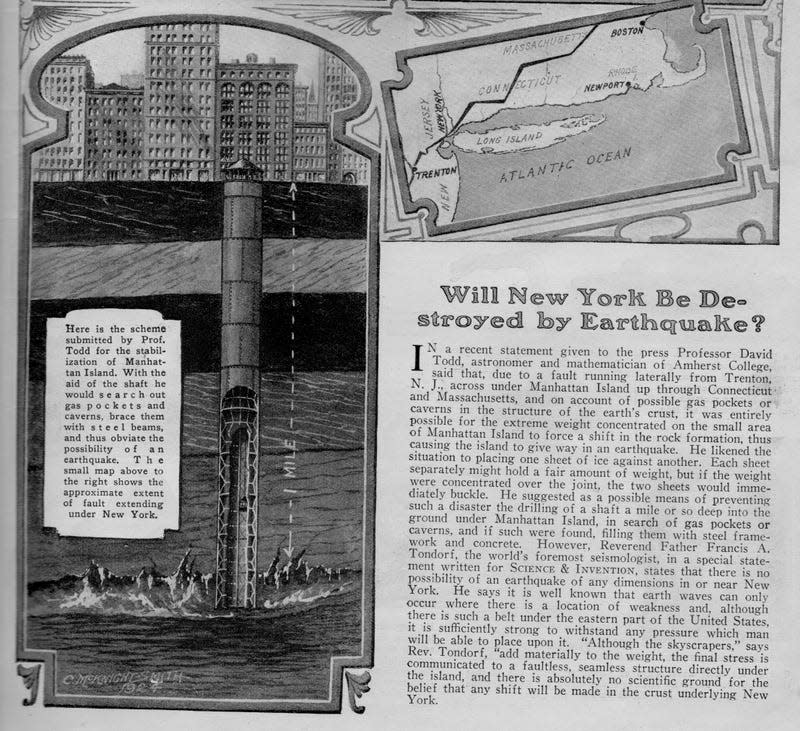
The 1924 article in Science and Invention quoted Professor David Todd, an astronomer at Amherst College, who was concerned about the possibility of a major earthquake in New York.
In a recent statement given to the press Professor David Todd, astronomer and mathematician of Amherst College, said that due to a fault running laterally from Trenton, N.J., across under Manhattan Island up through Connecticut and Massachusetts, and on account of possible gas pockets or caverns in the structure of the earth’s crust, it was entirely possible for the extreme weight concentrated on the small area of Manhattan Island to force a shift in the rock formation, thus causing the island to give way in an earthquake. He likened the situation to placing one sheet of ice against another. Each sheet separately might hold a fair amount of weight, but if the weight were concentrated over the joint, the two sheets would immediately buckle.
But readers were told not to worry. There was a solution! It just happened to involve drilling a mine shaft deep within the Earth to let gas escape.
He suggested as a possible means of preventing such a disaster the drilling of a shaft a mile or so deep into the ground under Manhattan Island, in search of gas pockets or caverns, and if such were found, filling them with steel framework and concrete.
The potential consequences of drilling into the Earth weren’t out of nowhere, of course. Fracking has caused a number of earthquakes in the central plains states.
Skyscrapers Vulnerable
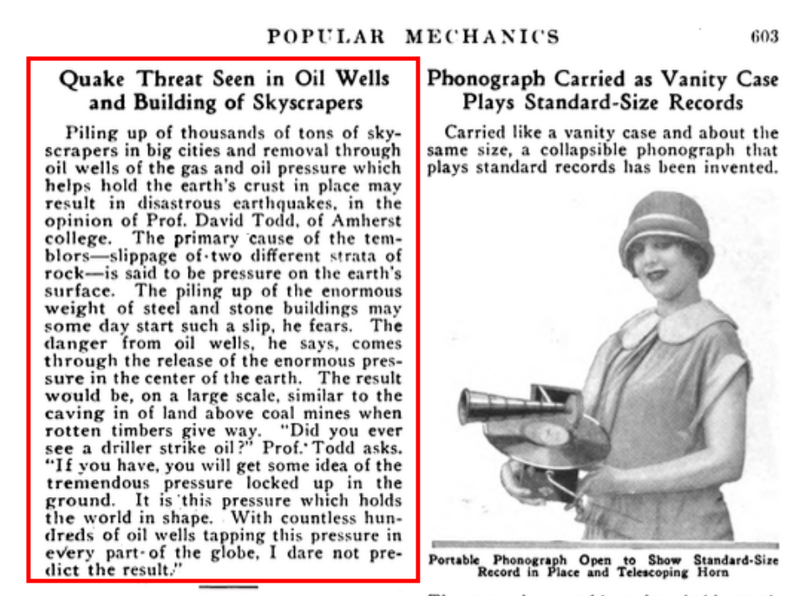
The October 1924 issue of Popular Mechanics magazine also looked at the issue, focusing on the immense weight of buildings in Manhattan, which might cause problems down the line. The news item was relatively small, but ran right next to a very cool photo of a small phonograph player modeled by a flapper, this being the 1920s and all.
Was That a Subway Train?
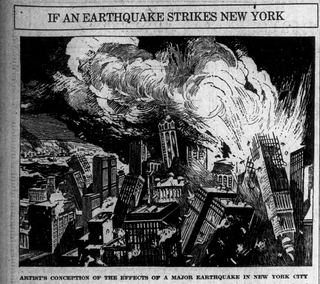
Unlike the predictions in Popular Mechanics and Science and Invention, this article tried to calm down any fears with some reassurances that sound pretty interesting in hindsight.
The September 23, 1923,Chattanooga Daily Times explained:
Scientists agree that unless some marked change comes about that New York City has small reason to remain awake at night wondering if the thunder of the passing subway train or the jolt of the loaded truck passing in the street outside is but the preliminary quiver of the earth which will bring down these tall buildings in a mass of twisted, smoking ruins.
The idea that an earthquake in New York might be mistaken for a loud truck or a subway train definitely happened, as anyone who was on X could tell you Friday morning.
“I know NYC has warped my brain bc the earthquake happened and for the first 10 seconds as my building shook I was like ‘is that a train? wait…I don’t live above the subway,’” writer David Mack wrote in a tweet expressing the same confusion that was echoed repeatedly on social media.
1924 Imagined an Earthquake in 1932
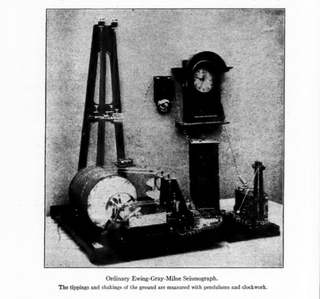
The October 1924 issue of Scribner’s magazine also tackled the issue of earthquakes in an article that imagined the aftermath of a horrible New York earthquake in 1932:
After the New York earthquake of 1932 a group of surviving bankers and publicists were discussing the situation in a Scarborough home that survived the catastrophe. The losses had been about nine hundred thousand lives and fifty billions of dollars. The business district of Manhattan was a mass of smouldering ruins with the army and the State militia burning corpses in pits and cleaning up the rubbish. The outstanding fact of the earthquake was that skyscraper construction had utterly failed, and every elevator had gone out of action. With the arctic gale that was blowing, fire-escapes had been covered with icicles and wholly inadequate. Panic and fire had produced most of the deaths and the lack of park-ways in lower Manhattan had created congestion of automobiles that the Fire Department was unable to cope with.
The article went on to describe how 300,000 people had been “asphyxiated and roasted underground,” in the subway system. And 300 “leading statesmen” were killed in this hypothetical future scenario because a big political convention was in town. Even the president and Secretary of War were killed, according to the article’s fantastical imagining.
There were also refugees in Central Park, of course, based on Scribner’s telling of it.
From 59th Street north there was much earthquake damage, but the fires
had been better handled. Eight hundred thousand refugees were camped in Central Park. The Brooklyn refugees were under martial law in the Garden City district. One hundred and twenty-four thousand corpses had been collected in the North and East Rivers, and many of the ferry slips and docks had broken down from the caving away of the main land.
Yikes.
Worries About Nuclear Power Plants
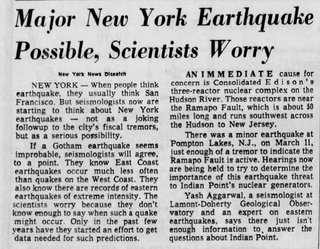
The April 29, 1976 edition of the Orlando Sentinel also ran a short piece syndicated from the New York News Dispatch about worries from scientists about the future of an earthquake in New York. And one of the biggest fears was that something might happen to the Indian Point Energy Center, a nuclear power plant on the Hudson River that ceased operations in 2021.
Notably, this short article was published less than three years before the 1979 meltdown at Three Mile Island, which wasn’t caused by an earthquake.
New York Magazine’s Big One
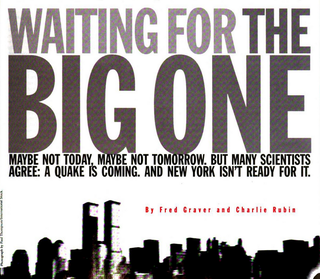
The December 11, 1995 issue of New York magazine also tackled the issue, talking with experts at length about the dangers of a big earthquake in Manhattan.
The riskiest local buildings: unreinforced masonry—our brownstones and walk-ups. Charles Scawthorn, who did a pioneering study on the possibility of a New York City quake for the New York Academy of Sciences in 1988 (to date, the only such study) imagines. “The streets would be filled with bricks. and you’d literally be looking up at a guy in his bathtub. That kind of comic-book scene. You’d just have bricks everywhere. Thousands. Tens of thousands. Hundreds of thousands.”
It presents a humorous scene. But given everything we know about how disasters actually play out here in the 21st century, it probably wouldn’t be quite so funny to the people living through it.

